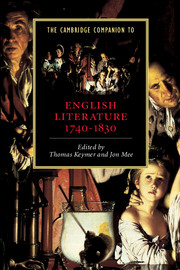Book contents
- Frontmatter
- Part I Contexts and modes
- 1 Readers, writers, reviewers, and the professionalization of literature
- 2 Criticism, taste, aesthetics
- 3 Literature and politics
- 4 Literature, national identity, and empire
- 5 Sensibility
- 6 Theatrical culture
- 7 Gothic
- Part II Writers, circles, traditions
- Index
- Series list
6 - Theatrical culture
from Part I - Contexts and modes
Published online by Cambridge University Press: 28 May 2006
- Frontmatter
- Part I Contexts and modes
- 1 Readers, writers, reviewers, and the professionalization of literature
- 2 Criticism, taste, aesthetics
- 3 Literature and politics
- 4 Literature, national identity, and empire
- 5 Sensibility
- 6 Theatrical culture
- 7 Gothic
- Part II Writers, circles, traditions
- Index
- Series list
Summary
It is only comparatively recently, as a result of realignments in the disciplines of literary studies and history, that the centrality of the theatre in Georgian culture and society has been properly recognized. As the pre-eminent forum of entertainment, art and instruction, the status of which was affirmed by royal authority in the form of patents or licences to perform, and by parliamentary scrutiny in the form of censorship, the stage loomed large in the Georgian cultural landscape, often literally so. The imposing neo-classical edifices of Covent Garden and Drury Lane theatres, employing thousands of people, were unmistakable landmarks in Regency London, as indeed were the so-called 'minor' theatres across the Thames such as the Royal Coburg which competed with Covent Garden and Drury Lane in scale and opulence.1 As the memoirs, fiction, and visual art of the period suggest, the experience of theatre meant much more than what was happening on the stage, striking though that was with its spectacular scenery and effects, and the towering presence of star actors. It also entailed the drama of the audience’s self-representation, ranging from the crush of bodies outside the pit door, the display of dandies and prostitutes in the lobbies, to the monarch’s appearances in the royal box. The role of Covent Garden and Drury Lane in metropolitan life was emulated, with varying degrees of success, by many smaller theatres throughout the British isles.
- Type
- Chapter
- Information
- The Cambridge Companion to English Literature, 1740–1830 , pp. 100 - 118Publisher: Cambridge University PressPrint publication year: 2004



